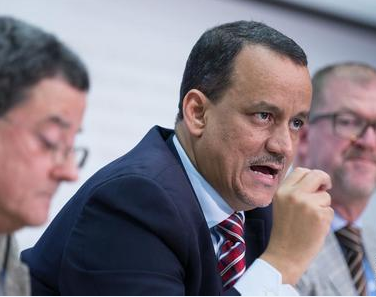JUDY WOODRUFF: Now, Yemen. There were small signs of progress today at peace negotiations, but no sign the shooting will stop in a country that's been wracked by conflict for more than a year.
Our chief foreign correspondent Margaret Warner reports.
MARGARET WARNER: It doesn't look like a cease-fire in Yemen this week.
Tanks are still blasting, gunfire still cracking across battle lines, and dozens being killed. Each side blames the other.

AMIN ABDULLAH, Pro-government fighter (through interpreter): The Houthis are the ones that rejected the United Nations and Security Council resolutions, who carried out attacks and struck residential homes and civilians. And we are just defending them.
MARGARET WARNER: The strife started in fall 2014, when Shiite Houthi rebels, backed by Iran, overran broad swaths of the country. They seized the capital Sana'a from government forces and militias loyal to President Abd-Rabbu Mansour Hadi. He spent months in exile in Saudi Arabia, returning only after a Saudi-led coalition of nine Sunni Arab states launched airstrikes in March against the Houthis.
Much of the coalition's weaponry comes from the U.S. and Britain. Fighting was supposed to halt this week, as U.N.-backed peace talks began in a small town in Switzerland.
ISMAIL OULD CHEIKH AHMED, U.N. SPECIAL ENVOY FOR YEMEN (through interpreter): Our meeting comes at a crucial moment in which threats and dangers abound and challenges are increasing both locally and regionally. The failure to reach a solution will have disastrous human and material consequences for the nation. Anyone who does not participate in the solution is effectively helping to perpetuate the crisis.
MARGARET WARNER: There's much at stake for the U.S. as well. Yemen is home to a lethal al-Qaeda affiliate, AQAP, which has tried to stage terror attacks in the U.S. Yemeni forces and U.S. air power had beaten back AQAP fighters, but the chaos has enabled them to regain much of that territory.
The strife has also made room for a new branch of the Islamic State group to take root. And the fighting the Houthis is diverting the Gulf countries from the broader war against ISIS.
What's more, it has ravaged what was already the Arab world's poorest country. Some 6,000 have been killed, and more than 2 million people have fled their homes.
MAJED MOHAMMED, Family displaced by fighting (through interpreter): We fled due to the shelling and shooting that continues to happen there. So I took my kids and came here.
MARGARET WARNER: Majed Mohammed lives in Taiz, Yemen's third largest city. Many families like his have found shelter in empty school buildings, abandoned because of the violence.
Indeed, entire neighborhoods now lie empty. The U.N. estimates the humanitarian crisis has affected 21 million people, more than 80 percent of the population.
ALI AHMED ALNAHARI, Sana'a resident (through interpreter): Some have fled to the countryside, some have fled the country all together, and some have fled to other cities. This neighborhood has become a town of ghosts.
MARGARET WARNER: Some aid deliveries are getting to Yemen, but distribution inside the country has been nearly impossible.
Tarak Bach Baouab of Doctors Without Borders" explains.
TARAK BACH BAOUAB, Head of Mission in Yemen, Doctors With: So it is much difficult for humanitarian workers to access those areas, for convoys to reach sometimes besieged areas, hospitals that are basically in areas which are completely surrounded by checkpoints and where different fighting parties are not allowing humanitarian assistance to get through.
MARGARET WARNER: U.S. officials hope these talks will lead to a permanent cease fire and a flow of aid. Today, negotiators did agree to let supplies into hard-hit Taiz and elsewhere. And Houthis and government fighters in Aden exchanged hundreds of prisoners.
But a political settlement of this devastating conflict still looks far away.












